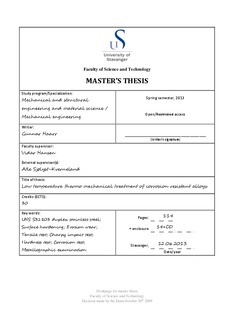| dc.description.abstract | Wear deteriorates materials and are a widespread problem in many areas of industry. To some extent, all physical materials experience wear in one form or another by moving gas, particles, fluids or a combination of these substances relative to the material in focus. More specifically, there must be an interaction between two objects in order to achieve an extent of material displacement or removal. Change of physical dimensions due to wear may have serious consequences with loss of functionality of a part. There are different methods available in order to minimize the effect of wear. The interaction between the two objects may be prevented, the relative motion and the velocity may be reduced and more. The preventive action is strongly dependent of the particular application, and in some cases the best method might be to enhance the wear resistance of a part. This may be done by changing material, heat treatment of base material or by some sort of surface engineering. This may include surface finishing, plating, coating or surface modification process by heat treatment.
Present work has focused on the low temperature surface treatment of corrosion resistant alloys as a mean to increase the resistance against erosive wear. Duplex stainless steel have been used as base material and a total of four different surface treatments have been evaluated and tested against erosive wear. These include two low temperature nitriding and/or carburizing methods called Expanite and Kolsterising, one thermal spray method called high velocity oxygen fuel (HVOF) coating with tungsten carbide and one nitriding method called Sursulf. In order to evaluate the possible effect on base material and confirm the existence of the surface, experimental tests have been performed in addition to the erosion test. Tensile test, Charpy impact test, hardness test, corrosion test and some metallographic examination are among the tests supporting the evaluation of the surface treatments.
Erosion tests showed that there is no surface treatment which is superior to the other treatments. There are advantages and disadvantages subjected to each of the surface treatment in question. Nevertheless, Expanite and Kolsterising showed an improvement on erosion rates relative to untreated duplex for particle impact angles in the range from 0° to somewhere between 30° and 90°, both at low and high particle velocity. HVOF and Sursulf, however, only showed superior good erosion rates when testing with high particle velocity. At 90° particle impact angle, untreated duplex was as good as the surface treated duplex, or even better, both at low and high velocity. Only HVOF could match and get lower erosion rate than untreated duplex at this angle, but only at high particle velocity.
In terms of the possible effect the surface treatments had on base material properties, the experimental results revealed several problems associated with precipitation of unwanted phases, brittleness and non homogeneous surface layer. Expanite and Kolsterising are heat treatments involving temperatures around 400°C. Even at this temperature, a close to 100 % brittle fracture was experienced on the Charpy impact test. Metallographic examinations also revealed precipitation of nitrides and/or carbides on these samples, and a non homogeneous surface layer was revealed on the Expanite samples. Precipitates were also found in samples treated with Sursulf method, but Charpy impact test did not show the same brittleness behavior. HVOF did not result in any significant change in microstructure. This surface treatment showed relative good results for all experiments, but the binder material may be subjected to corrosion reactions and material degradation under specific environments. | no_NO |
